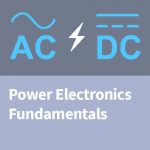Electromobility EVSE Developer Introduction
Exclusive CharIN E-Learning Package
The course combination is perfect for a developer starting in charging station EVSE development.

The “Electromobility EVSE Developer” e-learning package is a foundation level program that equips learners with essential knowledge and skills in the field of EVSE development. This package covers a wide range of topics to provide a well-rounded understanding.
Recommended learning journey
The first course EV charging ensures that you are getting to know the overall context. This includes general charging know-how on automated charging, charging use cases and grid interaction. After this we delve into the charging communication which takes place between the electric vehicle and the charging station.
Power electronics fundamentals is delving into semiconductors, introduces the concepts of the half bridge which for example is used to control electrical machines and finally is going into thermal design and application examples of your electronics.
Last but not least, you will learn about serial bus systems. They are a critical component of embedded systems, and learners will gain insights into their architecture, protocols, and components. The OSI model is also covered, providing an understanding of layered communication systems.
Get Started Today
Get your 12-week access to the Embedded Academy and the Electromobility EVSE Developer package now
Exclusive CharIN E-Learning Package
Electromobility EVSE Developer
Introduction 12 weeks e-learning package
Save your lower price!
720€ per License until May 31st.
900€ per License, starting June 1st.
All prices excl. 19% VAT. All licenses end after the respective period.
Need multiple accounts?
You need access for a team or for more people? Please feel free to contact us
EV Charging
- Language: English, German
- Course objective: The aim of this course is to first introduce the learner to all important aspects of electric vehicle charging and then educate them about the more advanced topic of communication in electric vehicle charging.
- Course content: First of all, the learner is made familiar with the basics of EV charging (charging modes, standards, levels). Afterwards, one e-learning focusses in particular on automated charging. To place EV charging into relation to our everyday life, use cases of EV charging are discussed as well. Moreover, it is also important to be informed about the grid interaction, which includes topics such as energy production and green energy.
The focus of the next two e-learnings is then on communication in electric vehicle charging. Therefore, first the concepts of the pilot signal and the duty cycle are introduced, before various communication mechanisms are described, the low-level and high-level communication for instance. Low level communication is, roughly speaking, the basic handshake, while high-level communication involves the transmission of much more data – including encrypted data.
Power Electronics Fundamentals
- Language: English
- Course objective: The aim of this course is to provide a better understanding of power electronics fundamentals for engineers who are beginning to work in this field.
- Course content: In the first e-learning we clarify what power electronics is and where it is applied. It also includes an explanation of the electronic switch. We deal with an example of an electronic circuit, from which we derive basic components. In the e-learning “Components of Power Electronics” you learn about the semiconductor basics and components including MOSFETs. The third e-learning is about the half bridge, that is used to control AC electrical machines and the last e-learning covers the topic of thermal design and assembly.
Introduction to Serial Bus System
- Language: English, German
- Course objective: The aim of this course is to introduce learners to all the important basic terms for the topic of serial bus systems.
- Course content: This course is designed to introduce you to important basic terms related to serial bus systems. Terms concerning hardware and software are explained.
The focus of the first e-learning lies on very general basic terms that are relevant to most bus systems. For example, the terms bit rate, baud rate, latency, clock signal and router are explained, or what a protocol and a protocol stack actually are. At the beginning of the e-Learning, typical application areas of serial bus systems and their advantages over other systems are described.
The second e-learning deals with the OSI model, which is a reference model for communication systems and protocols. Two components of this model are particularly relevant for bus systems: the so-called physical layer and the data link layer.
The last two e-learning courses are based on these mentioned layers. One of them covers basic terms of the physical layer, the other one those of the data link layer.


